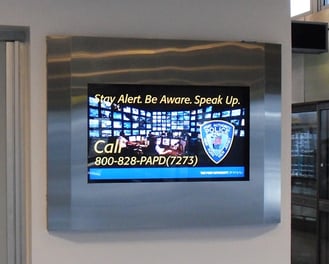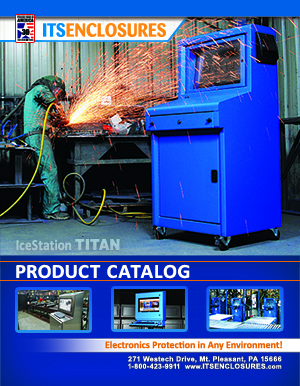In 2010, new ADA (Americans with Disabilities Act) regulations were put into place regarding accessible design for disabled Americans.
These changes particularly impact how digital signage can be installed in public places. Installations may include self-service kiosks, LCD enclosures, and video walls, just to name a few. These types of digital signage need to adhere to the proposed guidelines for ADA compliance. Ultimately, it just makes good business sense that a digital signage message is reachable and viewable to all users of the system. For example, one of the guidelines require a non-glare finish and 70% contrast between the sign background and lettering.
For the purpose of this blog, we will only address items associated with installing digital signage enclosures. For more helpful information on creating ADA friendly content, reference Kiosk Marketplace’s article “Meeting the ADA Compliance Challenge.”
Follow these 3 guidelines to successfully install ADA compliant LCD enclosures:
 Wall mounted LCD enclosures may not protrude more than 4 inches from the wall. If a visually impaired individual is walking near the digital signage, they may not be able to sense the enclosure with a walking stick or cane. Therefore, the enclosure must be very close to the wall. Popular solutions include recessed in-wall enclosures. However, remember to do the proper research before making an informed decision. Choose a solution that incorporates air ventilation and circulation to remove heat and keep the LCD operating at optimum temperatures. If the LCD cannot “breathe” properly, it will overheat and may go isotropic (blackening effect on the screen – which renders it useless).
Wall mounted LCD enclosures may not protrude more than 4 inches from the wall. If a visually impaired individual is walking near the digital signage, they may not be able to sense the enclosure with a walking stick or cane. Therefore, the enclosure must be very close to the wall. Popular solutions include recessed in-wall enclosures. However, remember to do the proper research before making an informed decision. Choose a solution that incorporates air ventilation and circulation to remove heat and keep the LCD operating at optimum temperatures. If the LCD cannot “breathe” properly, it will overheat and may go isotropic (blackening effect on the screen – which renders it useless).
- Touch enabled kiosks and digital signage enclosures must maintain a maximum height off the ground of 48-inches with a reach of 10 inches. Sloped style kiosks are usually wheelchair accessible and easy to use. A 15° to 20° slope allows the content to be easily accessed for users in a wheelchair. The enclosure should always be designed with consumers’ best interest in mind. Also, consider the accessibility of the touchscreen when designing the content. With advances in technology, IR (infrared) sensors can be used to customize content to display at a certain height range, but these options are often expensive to incorporate into a kiosk. Keep touchpoints low on the screen, and well within the reach of users.
- Digital signage enclosures must be installed 27-80 inches off of the ground or floor. Again, this regulation allows for the visually impaired to navigate around the signage. According to the website, novapolymers.com, “The 2010 Standard changed the mounting requirements for ADA signs… An important thing to note is that the mounting height of the sign is based on the height of the tactile characters above the finished floor. This means that the flooring needs to be factored in when determining the placement of the signs.” Another important note, for floor based enclosures, the ground space around the enclosure must be a minimum of 30” by 48”.
A misconception of ADA compliance is that it only applies to wheelchair accessibility, but it applies to many other situations. Guidelines also need to meet those whom are visually and hearing impaired. In addition, always remember that large and bulky signage makes it more difficult to meet ADA compliance. Research the options available to devise the cleanest, sleek solution that is guaranteed to work in the proposed environment.
For more information:
- Touchscreen LCD Enclosures vs. Non-Touch for Retail
- 3 Tips for Using Digital Signage in Outdoor Wayfinding Projects
- 2 Types of LCD Enclosures Perfect for Workplace Digital Signage
- How to Integrate Touchscreen into an Outdoor LCD Enclosure
HAVE QUESTIONS?
LET US KNOW HOW WE CAN BEST ASSIST YOU! CONTACT AN 'ITSENCLOSURES EXPERT' AT 1-800-423-9911 -OR- SEND US AN EMAIL: INFO@ITSENCLOSURES.COM



